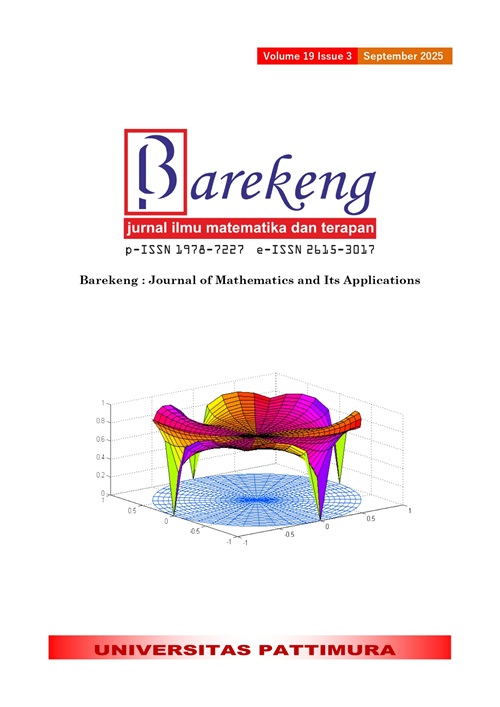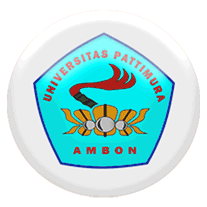MAPPING EARTHQUAKE MAGNITUDES IN BENGKULU PROVINCE AND SURROUNDING AREAS USING ROBUST ORDINARY KRIGING
Abstract
Bengkulu Province, situated in a subduction zone between the Indo-Australian and Eurasian plates, is highly susceptible to significant seismic activity, including major earthquakes in 2000 and 2007 with magnitudes exceeding 7. This research investigates the geographical distribution of earthquake magnitudes in Bengkulu Province and surrounding areas from 2000 to 2023. Understanding these spatial patterns is crucial for enhancing disaster preparedness and risk mitigation strategies in this high-risk region. Previous studies on earthquake distribution in Indonesia have provided valuable insights but often struggle with outliers and data variability, limiting their accuracy. Conventional Ordinary Kriging methods, though widely used, are sensitive to outliers, leading to potential inaccuracies. This study addresses these limitations by applying a robust Ordinary Kriging approach, which effectively mitigates the influence of outliers, thereby improving prediction reliability. The research utilizes earthquake data, including geographical coordinates and recorded magnitudes. It applies both classical and robust experimental semivariograms (Cressie-Hawkins) to model the spatial structure using theoretical variogram models—spherical, exponential, and Gaussian. The best-fit model is determined based on the lowest root mean square error (RMSE), ensuring accurate representation of spatial patterns. The results demonstrate that robust Ordinary Kriging accurately maps the spatial distribution of earthquake magnitudes, revealing clusters of higher magnitude events in specific regions of Bengkulu Province. These findings identify high-risk areas, providing essential data for disaster mitigation and risk management planning. This study significantly contributes to the field of seismology and geostatistics by enhancing the accuracy of magnitude distribution mapping. The resulting maps support local governments, urban planners, and disaster response organizations in developing more effective mitigation strategies, improving infrastructure resilience, and strengthening early warning systems. Ultimately, this research aims to foster safer, more prepared communities in Bengkulu Province and beyond.
Downloads
References
T. Zera, Sutrisno, and A. Budiono, “COMPARISON AMONG THE THREE PEAK GROUND ACCELERATION MODELS IN BENGKULU PROVINCE, INDONESIA,” IOSR J. Appl. Geol. Geophys., vol. 5, no. 1, pp. 31–36, 2017, doi: https://doi.org/10.9790/0990-0501013136.
O. Berke, “EXPLORATORY DISEASE MAPPING: KRIGING THE SPATIAL RISK FUNCTION FROM REGIONAL COUNT DATA,” Int. J. Health Geogr., vol. 3, pp. 1–11, 2004, doi: https://doi.org/10.1186/1476-072X-3-18.
F. Faisal, P. Novianti, and J. Rizal, “THE APPLICATION OF SPATIAL ANALYSIS AND TIME SERIES IN MODELING THE FREQUENCY OF EARTHQUAKE EVENTS IN BENGKULU PROVINCE,” Aceh Int. J. Sci. Technol., vol. 7, no. 2, pp. 103–114, 2018, doi: https://doi.org/10.13170/aijst.7.2.8656.
W. Erlangga, M. Teguh, M. Mushthofa, I. Trianggoro Saputro, and G. Setiadi, “SEBARAN GEMPA UTAMA BERDASARKAN MAGNITUDO DAN KEDALAMAN DI WILAYAH MAMUJU DAN SEKITARNYA,” Teknisia, vol. 27, no. 2, pp. 122–131, 2022, doi: https://doi.org/10.20885/teknisia.vol27.iss2.art6.
Y. Andika and I. Trianggoro Saputro, “PEMETAAN SEBARAN KEJADIAN GEMPA BUMI DI PROVINSI PAPUA,” J. Rekayasa, vol. 12, no. 2, pp. 109–119, 2022, doi: https://doi.org/10.37037/jrftsp.v12i2.147.
N. L. Humairah and A. Fauzan, “SPATIAL INSIGHTS INTO EARTHQUAKE STRENGTH: A SULAWESI CASE STUDY USING ORDINARY AND ROBUST KRIGING METHODS,” BAREKENG J. Ilmu Mat. dan Terap., vol. 18, no. 2, pp. 1283–1296, 2024, doi: https://doi.org/10.30598/barekengvol18iss2pp1283-1296.
L. Z. Mase, N. Sugianto, and Refrizon, “SEISMIC HAZARD MICROZONATION OF BENGKULU CITY, INDONESIA,” Geoenvironmental Disasters, vol. 8, no. 1, 2021, doi: https://doi.org/10.1186/s40677-021-00178-y.
T. Boen, “BENGKULU & WEST SUMATRA EARTHQUAKES, SEPTEMBER 12, 2007, STRUCTURAL DAMAGE REPORt,” pp. 1–25, 2007, [Online]. Available: https://www.eeri.org/lfe/pdf/indonesia_sept07_boen.pdf
“USGS.” Accessed: Mar. 13, 2024. [Online]. Available: https://www.usgs.gov/
N. A. C. Cressie, STATISTICS FOR SPATIAL DATA, Revised Ed. John Wiley & Sons, Inc., 1993. doi: https://doi.org/10.1002/9781119115151.
M. A. Oliver and R. Webster, BASIC STEPS IN GEOSTATISTICS: THE VARIOGRAM AND KRIGING. in SpringerBriefs in Agriculture. Cham: Springer International Publishing, 2015. doi: https://doi.org/10.1007/978-3-319-15865-5.
O. Erten, E. Pardo-Igúzquiza, and R. A. Olea, “ASSESSMENT OF EXPERIMENTAL SEMIVARIOGRAM UNCERTAINTY IN THE PRESENCE OF A POLYNOMIAL DRIFT,” Nat. Resour. Res., vol. 29, no. 2, pp. 1087–1099, 2020, doi: https://doi.org/10.1007/s11053-019-09496-3.
H. Lebrenz and A. Bárdossy, “ESTIMATION OF THE VARIOGRAM USING KENDALL’S TAU FOR A ROBUST GEOSTATISTICAL INTERPOLATION,” J. Hydrol. Eng., vol. 22, no. 9, pp. 1–8, 2017, doi: https://doi.org/10.1061/(asce)he.1943-5584.0001568.
X. L. Sun, Y. J. Wu, C. Zhang, and H. L. Wang, “PERFORMANCE OF MEDIAN KRIGING WITH ROBUST ESTIMATORS OF THE VARIOGRAM IN OUTLIER IDENTIFICATION AND SPATIAL PREDICTION FOR SOIL POLLUTION AT A FIELD SCALE,” Sci. Total Environ., vol. 666, pp. 902–914, 2019, doi: https://doi.org/10.1016/j.scitotenv.2019.02.231.
E. Mahdi, A. H. Abuzaid, and A. M. A. Atta, “EMPIRICAL VARIOGRAM FOR ACHIEVING THE BEST VALID VARIOGRAM,” Commun. Stat. Appl. Methods, vol. 27, no. 5, pp. 547–568, 2020, doi: https://doi.org/10.29220/CSAM.2020.27.5.547.
P. Moraga, SPATIAL STATISTICS FOR DATA SCIENCE: THEORY AND PRACTICE WITH R, 1st Ed. Chapman and Hall/CRC, 2024. doi: https://doi.org/: 10.1201/9781032641522.
G. Sahbeni and B. Székely, “EURASIAN JOURNAL OF SOIL SCIENCE SPATIAL MODELING OF SOIL SALINITY USING KRIGING INTERPOLATION TECHNIQUES : A STUDY CASE IN THE GREAT HUNGARIAN PLAIN,” vol. 11, no. 2, pp. 102–112, 2022.
Y. Li, M. Li, Z. Liu, and C. Li, “COMBINING KRIGING INTERPOLATION TO IMPROVE THE ACCURACY OF FOREST ABOVEGROUND BIOMASS ESTIMATION USING REMOTE SENSING DATA,” vol. 8, 2020, doi: https://doi.org/10.1109/ACCESS.2020.3008686.
B. Sadhukhan, S. Chakraborty, and S. Mukherjee, “PREDICTING THE MAGNITUDE OF AN IMPENDING EARTHQUAKE USING DEEP LEARNING TECHNIQUES,” Earth Sci. Informatics, pp. 803–823, 2023, doi: https://doi.org/10.1007/s12145-022-00916-2.
R. J. Geller, “EARTHQUAKE PREDICTION : A CRITICAL REVIEW,” Geophys. J. Int., vol. 131, no. 3, pp. 425–450, 1997.
F. Faisal, P. Novianti, and S. Yosmar, “ORDINARY KRIGING METHOD USING ISOTROPIC SEMIVARIOGRAM MODEL FOR ESTIMATING THE EARTHQUAKE STRENGTH IN BENGKULU PROVINCE,” in Proceedings of the International Conference on Mathematics and Islam, SCITEPRESS - Science and Technology Publications, 2018, pp. 34–40. doi: https://doi.org/10.5220/0008516800340040.
Copyright (c) 2025 Baki Swita, Mulia Astuti, Fachri Faisal, Aang Nuryaman

This work is licensed under a Creative Commons Attribution-ShareAlike 4.0 International License.
Authors who publish with this Journal agree to the following terms:
- Author retain copyright and grant the journal right of first publication with the work simultaneously licensed under a creative commons attribution license that allow others to share the work within an acknowledgement of the work’s authorship and initial publication of this journal.
- Authors are able to enter into separate, additional contractual arrangement for the non-exclusive distribution of the journal’s published version of the work (e.g. acknowledgement of its initial publication in this journal).
- Authors are permitted and encouraged to post their work online (e.g. in institutional repositories or on their websites) prior to and during the submission process, as it can lead to productive exchanges, as well as earlier and greater citation of published works.






1.gif)



